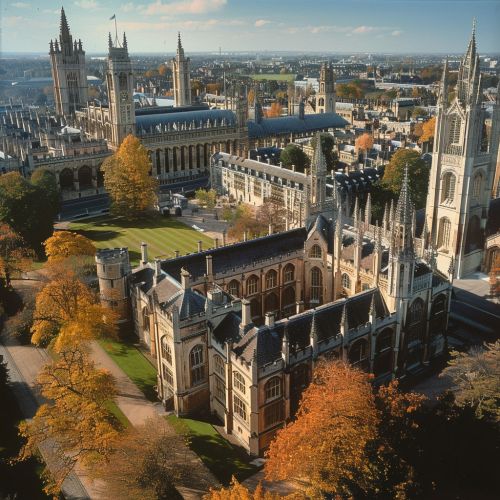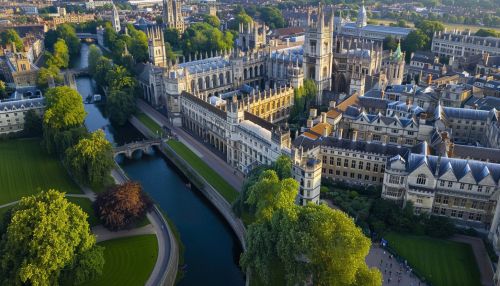Andrew Wiles: Difference between revisions
No edit summary |
No edit summary |
||
| Line 2: | Line 2: | ||
Andrew John Wiles was born on April 11, 1953, in Cambridge, England. His father, Maurice Frank Wiles, was the Regius Professor of Divinity at the [[University of Oxford|Oxford University]]. Wiles attended King's College School, Cambridge, and then The Leys School, Cambridge. | Andrew John Wiles was born on April 11, 1953, in Cambridge, England. His father, Maurice Frank Wiles, was the Regius Professor of Divinity at the [[University of Oxford|Oxford University]]. Wiles attended King's College School, Cambridge, and then The Leys School, Cambridge. | ||
[[Image:Detail-77831.jpg|thumb|center|Aerial view of King's College, Cambridge]] | [[Image:Detail-77831.jpg|thumb|center|Aerial view of King's College, Cambridge|class=only_on_mobile]] | ||
[[Image:Detail-77832.jpg|thumb|center|Aerial view of King's College, Cambridge|class=only_on_desktop]] | |||
Wiles' interest in mathematics began at an early age. At the age of 10, he discovered [[Fermat's Last Theorem|Fermat's Enigma]] in his local library. The theorem, which was first proposed by Pierre de Fermat in 1637, had remained unsolved for more than 300 years. Intrigued by the challenge, Wiles decided to dedicate his life to solving this mathematical mystery. | Wiles' interest in mathematics began at an early age. At the age of 10, he discovered [[Fermat's Last Theorem|Fermat's Enigma]] in his local library. The theorem, which was first proposed by Pierre de Fermat in 1637, had remained unsolved for more than 300 years. Intrigued by the challenge, Wiles decided to dedicate his life to solving this mathematical mystery. | ||
Latest revision as of 23:39, 7 May 2024
Early Life and Education
Andrew John Wiles was born on April 11, 1953, in Cambridge, England. His father, Maurice Frank Wiles, was the Regius Professor of Divinity at the Oxford University. Wiles attended King's College School, Cambridge, and then The Leys School, Cambridge.


Wiles' interest in mathematics began at an early age. At the age of 10, he discovered Fermat's Enigma in his local library. The theorem, which was first proposed by Pierre de Fermat in 1637, had remained unsolved for more than 300 years. Intrigued by the challenge, Wiles decided to dedicate his life to solving this mathematical mystery.
In 1971, Wiles began his undergraduate studies at Merton College, Oxford. He graduated in 1974 with a Bachelor of Arts degree in Mathematics. He then went on to earn his Ph.D. in Mathematics from Clare College, Cambridge, in 1980. His dissertation, titled "Reciprocity Laws and the Conjecture of Birch and Swinnerton-Dyer," was supervised by John Coates.
Career and Research
After completing his Ph.D., Wiles spent two years at the Institute for Advanced Study in Princeton, New Jersey, where he worked alongside many prominent mathematicians, including Tate and Shimura. In 1982, he returned to the UK to take up a professorship at the University of Oxford.
Wiles' early research focused on elliptic curves, a subject that would later play a crucial role in his proof of Fermat's Last Theorem. In 1986, he made a significant contribution to the field with his proof of the Taniyama-Shimura-Weil conjecture for semistable elliptic curves.
In 1994, Wiles achieved what he had set out to do as a child: he proved Fermat's Last Theorem. The proof was published in the Annals of Mathematics in 1995. This monumental achievement earned him worldwide recognition and numerous awards, including the Abel Prize in 2016.
Fermat's Last Theorem
Fermat's Last Theorem states that there are no three positive integers a, b, and c that satisfy the equation a^n + b^n = c^n for any integer value of n greater than two. The theorem had puzzled mathematicians for centuries, as Fermat claimed to have a proof but never published it.
Wiles' proof of the theorem is based on the Taniyama-Shimura-Weil conjecture, which proposes a link between elliptic curves and modular forms. Wiles, with the help of his former student Richard Taylor, was able to prove this conjecture for a special class of semistable elliptic curves, thereby proving Fermat's Last Theorem.
Legacy and Impact
Wiles' proof of Fermat's Last Theorem has had a profound impact on the field of mathematics. It has led to the development of new areas of research and has influenced many subsequent proofs. Wiles' work has also had a significant cultural impact, inspiring books, documentaries, and even a play.
Despite his monumental achievement, Wiles remains humble. He continues to teach and conduct research at the University of Oxford, inspiring the next generation of mathematicians.
